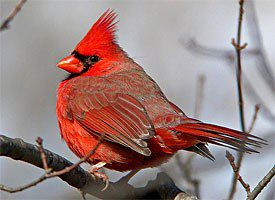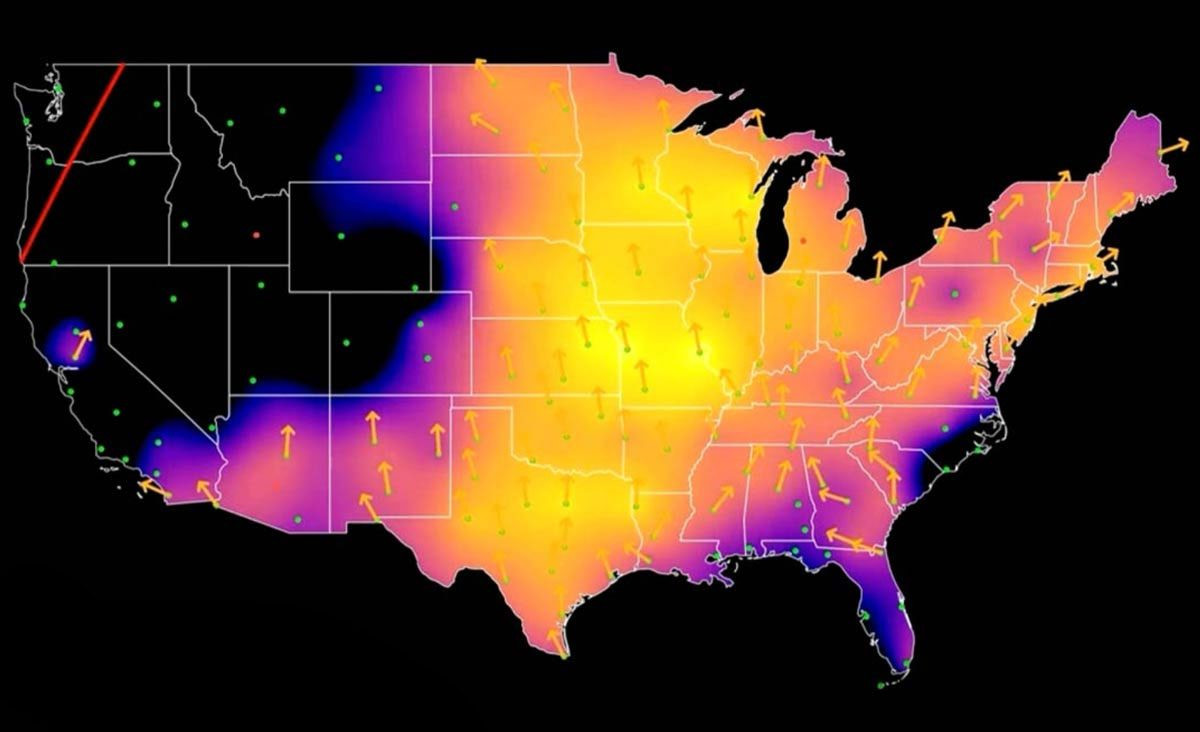Where Do Birds Fly In The Winter? Birds migrate to warmer regions with abundant food sources to survive the harsh winter months. Flyermedia.net provides an in-depth look at bird migration patterns and the factors that influence these incredible journeys, offering insights into avian behavior and navigation. Learn about the different types of migration, the hazards birds face, and how you can help these amazing creatures on their annual journeys.
1. Why Birds Migrate: The Quest for Resources
Birds migrate primarily to move from areas with diminishing resources to areas abundant with food and nesting locations. As Dr. Kevin McGowan from the Cornell Lab explains, migration is almost always about finding food, not just escaping the cold. Birds can withstand cold temperatures if they have enough to eat.
The primary reasons why birds migrate are:
- Food Availability: As winter approaches in the Northern Hemisphere, insect populations decline, and plants stop producing, leading to food scarcity. Birds migrate to regions where these resources are still plentiful.
- Nesting Locations: The Northern Hemisphere offers abundant nesting locations during the spring and summer, but these become inhospitable in winter.
2. What Triggers Bird Migration?
Migration is triggered by a combination of factors, including changes in day length, temperature, food supplies, and genetic predisposition. The change in daylight is the primary cue, causing hormonal changes that prompt migratory behavior.
2.1. Zugunruhe: Migratory Restlessness
Cage birds exhibit a behavior known as zugunruhe, or migratory restlessness, each spring and fall. This restlessness is a clear indication of the bird’s innate drive to migrate. According to research, even captive birds experience this urge, highlighting the strong genetic component of migration.
2.2. Variable Timing
While some species migrate with remarkable precision, the timing of migration can vary based on weather and local conditions. Red-winged Blackbirds, for example, arrive in central New York within a predictable two-week period.
3. Types of Bird Migration: Distance Matters
Migration can be categorized based on the distance traveled:
- Permanent Residents: These birds do not migrate and can find adequate food year-round.
- Short-Distance Migrants: They make small movements, such as from higher to lower elevations.
- Medium-Distance Migrants: These birds cover distances spanning a few hundred miles.
- Long-Distance Migrants: They typically move from breeding ranges in the United States and Canada to wintering grounds in Central and South America.
 northern cardinal
northern cardinal
4. The Origins of Long-Distance Migration: An Evolutionary Perspective
The origins of long-distance migration are complex, evolving over thousands of years. Genetic makeup, weather, geography, food sources, and day length all play a role. One theory suggests that birds breeding in the tropics dispersed northward over generations, taking advantage of seasonal food abundance and longer days to raise more young.
Most North American vireos, flycatchers, tanagers, warblers, orioles, and swallows evolved from tropical forms, supporting this theory.
5. Bird Navigation: How Do Birds Find Their Way?
Migrating birds cover thousands of miles, often following the same course yearly. First-year birds can navigate to their winter homes without prior experience. Their navigational skills combine several senses:
- Sun and Stars: Birds use celestial cues for direction.
- Earth’s Magnetic Field: They can sense the Earth’s magnetic field to determine north and south.
- Landmarks: Birds use visual landmarks during the day.
- Sense of Smell: Some species, like homing pigeons, may use their sense of smell.
Some species, especially waterfowl and cranes, follow preferred pathways related to stopover locations with critical food supplies. Smaller birds migrate in broad fronts, using different routes in spring and fall to exploit weather and food patterns.
 Blue Jay perched on a branch
Blue Jay perched on a branch
6. Migration Hazards: Challenges Along the Way
Migration is a dangerous journey that tests birds’ physical and mental capabilities. Hazards include:
- Physical Stress: The long journey is physically demanding.
- Lack of Food: Inadequate food supplies along the way weaken birds.
- Bad Weather: Storms and adverse weather conditions can disorient and exhaust birds.
- Predators: Increased exposure to predators raises the risk of attack.
- Tall Buildings and Communication Towers: Light pollution attracts birds, leading to fatal collisions.
Organizations like the Fatal Light Awareness Program (FLAP) and BirdCast’s Lights Out project work to mitigate these dangers.
7. Studying Bird Migration: Unlocking the Secrets
Scientists use various techniques to study migration:
- Banding: Placing bands on birds’ legs to track their movements.
- Satellite Tracking: Attaching satellite transmitters to birds to monitor their journeys in real-time.
- Geolocators: Using lightweight devices to record birds’ locations.
These methods help locate important stopover and wintering locations, enabling conservation efforts.
Each spring, about 500,000 Sandhill Cranes and some endangered Whooping Cranes use Nebraska’s Platte River as a staging habitat during their northward migration.
8. What is a Migrant Trap?
Migrant traps are locations that concentrate migrating birds in larger numbers than usual. These hotspots are often the result of weather conditions, food abundance, or local topography.
 Bird trap illustration
Bird trap illustration
8.1. Examples of Migrant Traps
- Gulf Coast States: Small songbirds migrating north over the Gulf of Mexico often land on the Gulf Coast. Storms or headwinds can exhaust them, leading them to seek food and cover in live-oak groves, creating a “fallout” of migrants.
- Peninsulas: Peninsulas like Point Pelee, Ontario; the Florida Keys; Point Reyes, California; and Cape May, New Jersey concentrate migrating birds as they follow the land before launching over water.
8.2. Attracting Migrants to Your Backyard
Offering diverse food sources, water, and natural food sources can attract migrating songbirds to your backyard, especially during spring migration.
9. Using Range Maps to Track Bird Migration
Range maps in field guides help determine when and if a particular species might be present in an area. However, range maps can be confusing due to year-to-year variations and rapid expansions or contractions of species ranges.
Data-driven, digital range maps address these limitations, using eBird observations to produce animated maps showing species’ movements throughout the year.
10. BirdCast: Real-Time Migration Tracking
The BirdCast program uses radar to create real-time maps of nocturnal bird migration. It also predicts busy migration nights with 3-day forecasts. This information aids conservation decisions, such as wind turbine placement, and helps cities reduce building lights to prevent bird collisions through the Lights Out initiative.
Accurate migration models inform researchers about behavioral aspects of migration, how migration timing and pathways respond to climate change, and whether migration timing variations affect bird population size.
 BirdCast migration map
BirdCast migration map
11. How You Can Help Migrating Birds
There are several ways you can help migrating birds:
- Turn Off Lights at Night: Reduce light pollution in cities to prevent bird disorientation and collisions with buildings.
- Plant Native Plants: Provide natural food sources and habitats for migrating birds.
- Provide Water Sources: Offer fresh water in bird baths or small ponds.
- Keep Cats Indoors: Prevent cats from preying on vulnerable migrating birds.
- Support Conservation Organizations: Donate to organizations working to protect bird habitats and migration routes.
- Hummingbird Feeders: Hang hummingbird feeders with fresh sugar water until it gets cold to help migrating Hummingbirds along their way.
- Suet Feeders: Provide suet for other migrating birds in Suet Feeders
- Advocate for Bird-Friendly Policies: Support local and national policies that protect birds and their habitats.
12. FAQ About Bird Migration
12.1. Why do birds migrate south for the winter?
Birds migrate south to find food and nesting locations in warmer climates where resources are more abundant during the winter months.
12.2. How do birds know when to migrate?
Birds use a combination of environmental cues, including changes in day length, temperature, and food availability, along with a genetic predisposition, to determine when to migrate.
12.3. Do all birds migrate?
No, not all birds migrate. Some birds, known as permanent residents, stay in the same area year-round because they can find adequate food supplies.
12.4. What is zugunruhe?
Zugunruhe is a German term meaning migratory restlessness, which describes the anxious behavior of caged birds during migration season as they instinctively try to move in a particular direction.
12.5. How do birds navigate during migration?
Birds navigate using a combination of senses, including the sun, stars, Earth’s magnetic field, visual landmarks, and possibly even their sense of smell.
12.6. What are the main dangers birds face during migration?
The main dangers include physical stress, lack of food, bad weather, predators, and collisions with tall buildings and communication towers.
12.7. What is a migrant trap?
A migrant trap is a location that concentrates migrating birds in larger numbers than usual due to weather conditions, food abundance, or local topography.
12.8. How can I help migrating birds in my backyard?
You can help by offering diverse food sources, water, and natural food sources, turning off lights at night, and keeping cats indoors.
12.9. What is BirdCast?
BirdCast is a program that uses radar to create real-time maps of nocturnal bird migration and predict busy migration nights.
12.10. What are some examples of long-distance migrant birds?
Examples of long-distance migrant birds include warblers, swallows, and orioles, which typically move from breeding ranges in the United States and Canada to wintering grounds in Central and South America.
13. Further Exploration: Resources on Flyermedia.net
Flyermedia.net offers a wealth of information on bird migration and related topics. Explore our articles, guides, and resources to deepen your understanding of these fascinating avian journeys.
- Bird Training Programs: Discover options for training your own bird at flyermedia.net/bird-training-programs.
- Bird Behavior: Learn more about the behavior and habits of your favorite avian creatures at flyermedia.net/bird-behavior.
- Types of Bird Migration: Read about different types of bird migration and when they fly, visit: flyermedia.net/types-of-bird-migration.
By understanding bird migration and its challenges, we can take steps to protect these amazing creatures and ensure their survival for generations to come. Visit flyermedia.net to learn more about bird migration and how you can support avian conservation efforts.
Alt text: An American Kestrel perched on a branch, representing the beauty and resilience of migratory birds.